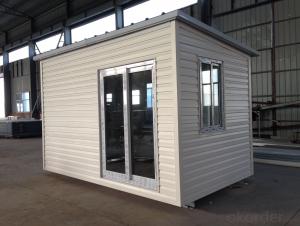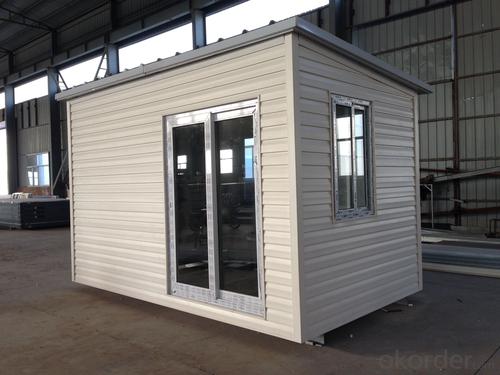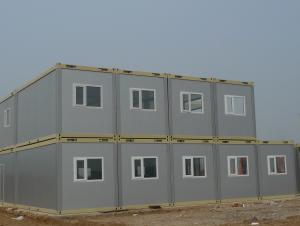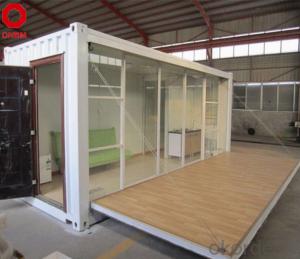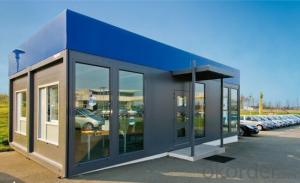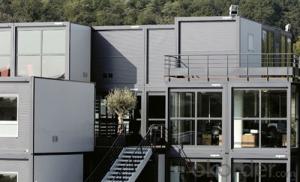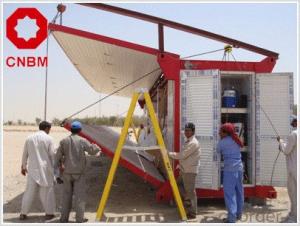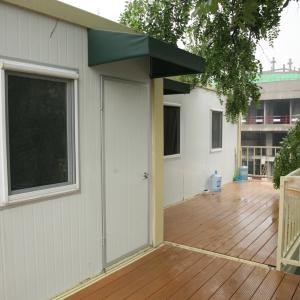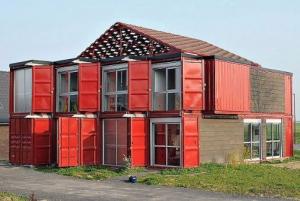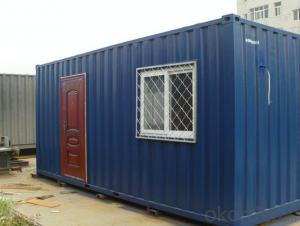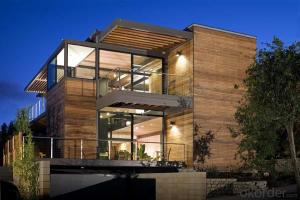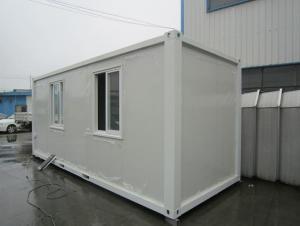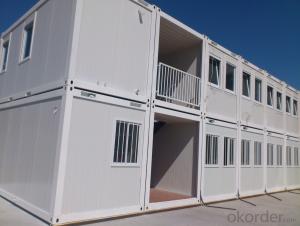Popular container house made in China
- Loading Port:
- China Main Port
- Payment Terms:
- TT OR LC
- Min Order Qty:
- -
- Supply Capability:
- -
OKorder Service Pledge
OKorder Financial Service
You Might Also Like
Beautiful Design Prefabricated House
Product Description:
1. The house is made of light steel structure and rustproof color steel sandwich panel as wall and roof. 2. The size and layout can be designed as per customers' requirements for its flexible dimension 3. The house has waterproof structure and heating insulation material, such as EPS, Rock wool or PU Panels interlock easily to form a complete thermally efficient shell. 4. Two kinds of flooring system are available, one is steel chassis floor, the other is concrete foundation. 5. One 40’HQ container can load about 160m2 considering 75mm thickness panel for roof and wall; 6. Six skilled workers can finish 42m2 in 8 hours ; 7. The house can resist heavy wind load of 0.5KN/m2 and 7-8 degree seismic intensity. |
|
Family house for low income people, Temporary homes for disaster area, Holiday and vocation house… |
Remote site constructions camping, Warehouse , Work shop… |
Company office, Dining halls, Dormitories, Hospitals, Saloons, Entertainment centers… |
our service:
1. House Production accordingto customer layout , design , specification
2. We have standard house model, but we can also make design according to
customer specialized target orbudget per m2. This way we can get a agreement
in the shortest time.
3. We can supply thefurniture, electricity and sanitary fittings, but we can only supply Chinesestandard and design style. If small quantity,
the best way is to purchase thefittings by customer in their site.
We supply the installation instruction. More important our house design policy is quick
and easy installation.
- Q: Are container houses suitable for temporary housing?
- Yes, container houses are suitable for temporary housing. Container houses are an innovative and cost-effective solution for temporary housing needs. They are built using repurposed shipping containers, which are durable, portable, and readily available. Container houses offer several advantages for temporary housing. Firstly, they can be quickly and easily assembled, making them ideal for emergency situations or areas with urgent housing needs. The containers can be transported and set up on-site in a short time frame, allowing for swift accommodation of displaced individuals or communities. Additionally, container houses are customizable and can be designed to meet specific requirements. They can be equipped with basic amenities such as insulation, electricity, plumbing, and heating/cooling systems, ensuring a comfortable living environment. Furthermore, containers can be stacked or arranged in various configurations to create larger living spaces or accommodate multiple families. Another advantage of container houses is their affordability. Shipping containers are relatively inexpensive compared to traditional building materials, making them a cost-effective solution for temporary housing projects. Moreover, the use of repurposed containers is environmentally friendly, as it reduces waste and promotes recycling. Container houses also have the advantage of mobility. They can be easily relocated to different sites, allowing for flexibility in responding to changing needs or situations. This is particularly beneficial for temporary housing projects that require mobility, such as disaster relief efforts or construction site accommodations. In conclusion, container houses are highly suitable for temporary housing. Their durability, portability, customization options, affordability, and mobility make them an excellent choice for emergency housing, disaster relief, construction site accommodations, and other temporary housing needs.
- Q: Are container houses suitable for permanent or temporary living?
- Depending on individual needs and preferences, container houses are versatile for both permanent and temporary living. For temporary living, they provide a cost-effective and flexible solution. They can be easily transported and set up in different locations, making them ideal for those who frequently move or require temporary accommodations, such as construction sites or disaster relief efforts. Alternatively, container houses can also be suitable for permanent living. With proper insulation, plumbing, and electricity installations, they can offer all the necessary amenities for a comfortable and functional home. Individuals or families can customize them to their specific requirements and aesthetic preferences, creating a unique living space. Container houses have several advantages for permanent living. They are environmentally friendly, repurposing used shipping containers and reducing environmental impact. Additionally, they are often more affordable than traditional houses, making homeownership accessible to a wider range of people. However, it is important to consider potential limitations of container houses for permanent living. The limited size of shipping containers may pose challenges for larger families or those who require more space. Modifying containers to meet building codes and regulations may also incur additional costs and time. Furthermore, the industrial look of container houses may not appeal to everyone's aesthetic preferences. In conclusion, container houses offer cost-effectiveness, flexibility, and eco-friendliness, making them suitable for various living situations. However, it is crucial to carefully consider the specific requirements and limitations before deciding on their suitability for a particular living arrangement.
- Q: Can container houses have multiple stories?
- Container houses are not restricted to single levels, contrary to what many people believe. It is possible to stack containers on top of each other to form multiple stories, as long as the appropriate design and structural modifications are made. By reinforcing the containers with extra steel beams and columns, a stable and secure structure can be created, capable of supporting multiple levels. Furthermore, container homes can also be expanded horizontally by adding more containers next to each other. This adaptability enables the construction of container houses with multiple stories, offering increased living space and meeting the requirements of larger families or diverse needs.
- Q: Can container houses be transported easily?
- Yes, container houses can be easily transported. Due to their modular design and standard size, they can be easily loaded onto trucks, ships, or trains and transported to different locations.
- Q: Can container houses be built with a contemporary gym or fitness area?
- Yes, container houses can certainly be built with a contemporary gym or fitness area. Container houses are versatile and can be customized to meet specific needs and preferences. With careful planning and design, a container house can be modified to include a dedicated space for a gym or fitness area. Container houses offer flexibility in terms of layout and design. They can be easily expanded or modified to accommodate additional rooms or sections. By utilizing multiple containers or modifying the existing structure, it is possible to create a separate area specifically for a gym or fitness space. When designing a container house with a gym or fitness area, certain factors need to be considered. Adequate space should be allocated for various gym equipment and exercises. Proper ventilation and lighting should be incorporated to create a comfortable and functional workout environment. Additionally, insulation and soundproofing measures may be necessary to ensure privacy and minimize noise disturbance. With the right planning and professional guidance, container houses can be transformed into contemporary living spaces with a dedicated gym or fitness area. This not only adds value and functionality to the house but also promotes a healthy and active lifestyle for its occupants.
- Q: Are container houses suitable for guest houses?
- Indeed, guest houses can certainly benefit from the use of container houses. The popularity of container houses continues to rise due to their affordability, sustainability, and versatility. These structures are constructed from repurposed shipping containers, which makes them a cost-effective choice for guest accommodations. Guest houses can be tailored to meet specific requirements using container houses. They can be designed to include all essential amenities such as bedrooms, bathrooms, kitchens, and living areas. Moreover, they can be modified to provide a pleasant and practical living space for guests. Furthermore, container houses possess the advantage of being portable, allowing for easy relocation if necessary. This flexibility permits homeowners to move the guest house to different parts of their property or even take it with them if they decide to relocate. Additionally, container houses are environmentally friendly. By utilizing repurposed shipping containers, these structures contribute to waste reduction and the promotion of sustainability. In an era where environmental consciousness is increasing, many guests appreciate staying in accommodations that prioritize sustainability. To sum up, container houses are undeniably suitable for guest houses. They offer affordability, versatility, and sustainability, making them an appealing choice for homeowners seeking to create comfortable and functional guest accommodations.
- Q: Are container houses suitable for remote or secluded locations?
- Yes, container houses are suitable for remote or secluded locations. They are highly versatile and can be easily transported to such areas. Container houses are durable, weather-resistant, and require minimal maintenance, making them ideal for harsh and isolated environments. Additionally, their modular nature allows for easy expansion or relocation as needed in remote locations.
- Q: Are container houses suitable for areas with high humidity?
- Container houses can be suitable for areas with high humidity, but certain precautions need to be taken. The metal structure of container houses can be prone to rust and corrosion in humid environments. However, with proper insulation and ventilation systems, the negative effects of high humidity can be minimized. It is important to ensure that the container is properly sealed, including the roof, walls, and floor, to prevent any moisture from entering. Additionally, using proper insulation materials and installing adequate ventilation systems, such as vents and fans, can help regulate the humidity levels inside the container house. Regular maintenance and inspection of the container's structure, especially the areas prone to rust and corrosion, are also necessary to ensure its longevity in high humidity areas. Overall, while container houses can be suitable for areas with high humidity, it requires careful planning and consideration to prevent any potential issues related to moisture.
- Q: Can container houses be built with a security system?
- Absolutely! It is indeed possible to incorporate a security system into container houses. Similar to traditional houses, container houses offer a range of security features to guarantee the well-being and safety of residents. Firstly, container houses can be equipped with the same types of security systems found in conventional homes, including burglar alarms, motion sensors, and security cameras. These systems can be strategically installed at entry points like doors and windows to detect any unauthorized access or suspicious activity. Moreover, container houses can make use of smart home technology to heighten security measures. This entails employing smart locks that can be controlled remotely through a smartphone application, ensuring that only authorized individuals can gain entry. By integrating with a home security system, homeowners can receive alerts and notifications on their phones in the event of any security breaches. Furthermore, container houses can reinforce their security by implementing measures that are specific to their unique structure. For example, the robust steel walls of container houses act as a deterrent to potential intruders. Windows can be fortified with security films or bars, while doors can be equipped with robust locks and deadbolts. Ultimately, the level of security in a container house can be tailored to meet the specific requirements and preferences of the homeowner. Whether opting for basic security measures or advanced smart home security systems, container houses can be constructed to provide a secure and protected living environment.
- Q: Can container houses be built in earthquake-prone areas?
- While it is possible to construct container houses in earthquake-prone areas, it is crucial to incorporate earthquake-resistant features during the design and construction process to guarantee their safety and stability. These features encompass reinforced foundations, flexible connections, and structural bracing. Collaborating with experienced architects and engineers well-versed in earthquake-resistant design principles is of utmost importance to ensure the ability of container houses to withstand seismic activity. Furthermore, adherence to local building codes and regulations is essential to guarantee compliance and safety. By employing proper planning, design, and construction techniques, the risks associated with earthquakes can be minimized, rendering container houses a feasible option in earthquake-prone regions.
Send your message to us
Popular container house made in China
- Loading Port:
- China Main Port
- Payment Terms:
- TT OR LC
- Min Order Qty:
- -
- Supply Capability:
- -
OKorder Service Pledge
OKorder Financial Service
Similar products
Hot products
Hot Searches
Related keywords
